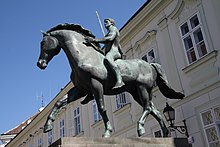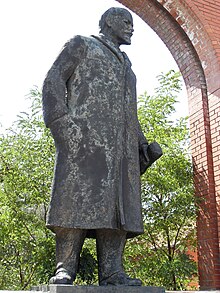Pál Pátzay



Pál Pátzay (born September 17, 1896 in Kapuvár , † September 14, 1979 in Budapest ) was a Hungarian sculptor and medalist .
Life
From 1910 to 1912 Pátzay was a student of Béla Radnai at the Academy of Fine Arts in Budapest . In 1917 he became a member of the artist movement Ma . From 1919 to 1922 he was involved in the Hungarian Soviet Republic , after which he had to flee Hungary and stayed for a while in Paris . In Hungary, which was authoritarian-led by the Horthy regime , Pátzay adapted politically and received public contracts with which he was supposed to satisfy the nationalist sentiment. In March 1944, his attempt to save the painter István Farkas from deportation by the Eichmann Command to Auschwitz failed .
After the Second World War , Pátzay was elected to the Hungarian parliament in the parliamentary elections in 1945 , which, however, was dissolved in 1947 under Soviet pressure. Pátzay was commissioned by Raoul Wallenberg for a memorial in memory of the rescue of the Jews , but shortly after its erection in Budapest in 1949 it was demolished for political reasons and disappeared under a different name in the province of Debrecen .
From 1945 to 1975 Pátzay worked at the Hungarian Academy of Fine Arts, among his students were Imre Varga , László Marton , Judit Kemény (1918–2009), Magda Gádor and Ilka Gedő . Pátzay was a recognized artist in communist Hungary who received public commissions and received numerous awards. In 1952, Pátzay received the Hungarian sculptor prize “Magyar Köztársaság Kiváló Művésze díj” and twice, in 1950 and 1965, the Kossuth Prize , and in 1970 the order “Flag of the People's Republic of Hungary”.
Pátzay's statue of Lenin was placed on Felvonulási Square in 1965. After the political turning point in 1989, it was removed there and has been shown in Szoborpark since 1993 together with other abandoned sculptures from the communist era.
Pátzay was first married to the psychoanalyst and child psychologist Lucy P. Liebermann (1899-1967). She was one of the founding members of the Hungarian Psychoanalytic Society. Liebermann had tried to emigrate to the United States , but she hadn't succeeded.
Pátzay had been married to Hertha Fuchs since 1945 and they had a son, János.
Pál Pátzay was posthumously named Righteous Among the Nations in 1998 .
Fonts
- The Hungarian painter Ödön v. Márffy: A modern painter , P. Gordon, Berlin 1929
literature
- Szinyei Merse Pál , Budapest: Officina, 1941
- Pátzay Pál, alkotás és szemlélet , Budapest, Magvető Könyvkiadó, 1967
- Ö. Gábor Pogány: Pátzay Pál: szobrászművész kiállítása , Budapest, Magyar Nemzeti Galéria 1976
- Sándor Kontha: Pátzay Pál , Budapest 1985
- Tanja Schult: A Hero's Many Faces. Raoul Wallenberg in Contemporary Monuments . Palgrave Macmillan, Houndmills Basingstoke-New York 2009, ISBN 978-0-230-22238-0 web (PDF; 124 kB)
Web links
- Literature by and about Pál Pátzay in the catalog of the German National Library
Individual evidence
- ↑ For the Hungarian group Ma see Hungarian Wikipedia hu: Ma (folyóirat)
- ↑ Tanja Schult: A Hero's Many Faces. Raoul Wallenberg in Contemporary Monuments , passim
- ↑ Judit Kemény at tatclassicart (hu)
- ^ Lucy P. Liebermann in psychoanalysts. Biographical lexicon
- ^ Paul Harmat: Freud, Ferenczi and the Hungarian psychoanalysis. Edition Diskord, Tübingen 1988, ISBN 3-89295-530-1 , p. 303
- ↑ Hertha Fuchs (1918–2007), b. in Vienna see Pátzay at kisalfold February 6, 2007
- ^ Pál Pátzay on the Yad Vashem website
| personal data | |
|---|---|
| SURNAME | Pátzay, Pál |
| BRIEF DESCRIPTION | Hungarian sculptor and politician, Member of Parliament |
| DATE OF BIRTH | 17th September 1896 |
| PLACE OF BIRTH | Kapuvár |
| DATE OF DEATH | September 14, 1979 |
| Place of death | Budapest |